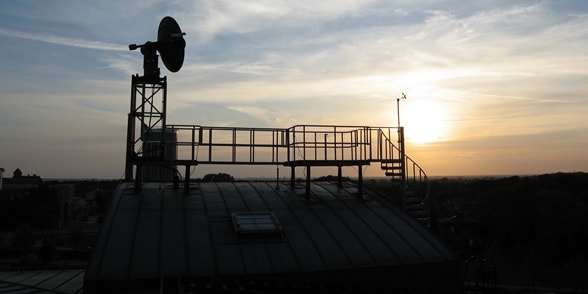The Common Swift, Apus apus, unusual flight behaviours have inspired research for decades (Lack, 1959). Spending almost a full year in the air (Hedenström et al., 2016), sleeping on the wing and engaging in screaming parties during summer nights (Henningsson, Johansson, & Hedenström, 2010)are some of the fascinating behaviours known of the Common Swift (from here on “Swifts”).
One particularly mysterious behaviour is the high-altitude ascents they perform at dusk and dawn. Soon after sunset large numbers of swifts rapidly ascend to high altitudes (up to 3000m). They then slowly decrease in altitude to spend the night at lower altitudes, only to slowly increase altitude again soon before sunrise and then finally rapidly descend (Dokter et al., 2013, Meier et al. 2018). The purpose of this seemingly energy demanding behaviour remains elusive, although many theories have been suggested. It could be a way to access orientation cues, such as star patterns and polarized light, at dusk and dawn. This fits well with dusk and dawn being important periods for orientation, but it is difficult to explain why swifts would need to ascend to such heights to access these cues.
Other explanations that have been suggested are that swifts use the ascents to better see surrounding weather and landscape features (Dokter et al., 2013) or that there is a connection to nocturnal foraging (Buurma, 2000).
By tracking these ascents we were able to reveal a new aspect of this fascinating behaviour; that swifts often make the first ascent and the final descent together in flocks. We are able to do this by using tracking radar, which supplies us with unique data on not only individual swifts flight behaviour, but, crucially, also the occurrence and behaviour of flocks of swifts.
We tracked swifts during seven summer nights over the town of Lund, Sweden. We recorded the exact position of the swifts each second, calculating the flight speeds, altitudes and the change in altitude (Vz). It is normally very difficult to classify species when using radar, but swifts have a specific wingbeat pattern that make them easily distinguishable from other species. We only included echoes that were clearly identified as individual swifts, or flock echoes where the individuals at some point were far enough apart for us to be able to identify a swift wingbeat pattern.
 Figure 1 Top: Mean altitude per 60 second periods of tracked swifts (orange) and flocks of swifts (blue), bottom: mean vertical speed per 60 second period of tracked swifts (orange) and flocks of swifts (blue). Black lines show GAM smoothed mean
Figure 1 Top: Mean altitude per 60 second periods of tracked swifts (orange) and flocks of swifts (blue), bottom: mean vertical speed per 60 second period of tracked swifts (orange) and flocks of swifts (blue). Black lines show GAM smoothed mean
Figure 1 shows how the altitude, as well as the change in altitude (the vertical speed, Vz) varies over the night. Positive vertical speeds mean that the birds are increasing in altitude, negative values that they are decreasing in altitude. Soon after sunset we see most birds gaining altitude rapidly, with high vertical speeds, as expected. This is followed by a slow decrease in altitude, with slightly negative vertical speeds. During the middle of the night vertical speeds level out and there is not much change in altitude. About an hour before sunrise the birds start to gain altitude again, although not as rapidly as after sunset. Around sunrise we see the birds rapidly decreasing in altitude, with very negative vertical speeds.
From figure 1 it is also apparent that the swifts gather in flocks mainly during two different periods, the evening ascent and the morning descent. These are also the periods with very rapid vertical speeds. No flocks were observed during the middle of the night, when the swifts are presumably sleeping on the wing. This flocking behaviour suggests some kind of social aspect to the rapid ascents and descent behaviours, perhaps in a similar manner to the screaming parties commonly observed during evenings. It is possible that the flocks we observe at relatively high altitudes after sunset, climbing rapidly, correspond to the groups of birds engaged in screaming parties before sunset.
Further studies will be needed to figure out what role this flocking behaviour plays in the twilight ascents, as well as the ultimate function of this fascinating behaviour.
Read the paper:
Flocking behaviour in the twilight ascents of Common Swifts Apus apus. Nilsson, C., Bäckman, J. & Dokter, A. M. 2019. IBIS. VIEW
Nominate this article for a BOU Science Communication Award.
References
Buurma, L. 2000. Dusk and Dawn ascend of the swift, Apus apus L. In J. van Nugteren (Ed.), Proceedings of the 25th Conference of the International Bird Strike Committee. Amsterdam, The Netherlands, 17-21 April 2000: Amsterdam: IBSC.
Dokter, A. M., Åkesson, S., Beekhuis, H., Bouten, W., Buurma, L., van Gasteren, H., & Holleman, I. 2013. Twilight ascents by common swifts, Apus apus, at dawn and dusk: Acquisition of orientation cues? Animal Behaviour 85(3): 545–552. VIEW
Hedenström, A., Norevik, G., Warfinge, K., Anderson, A., Baeckman, J., & Åkesson, S. 2016. Annual 10-month aerial life-phase in the common swift Apus apus. Current Biology 26(22): 3066-3070. VIEW
Henningsson, P. Johansson, C. and Hedenström, A. 2010. How Swift Are Swifts Apus Apus? Journal of Avian Biology 41(1): 94–98. VIEW
Lack, D. 1959. Swifts in a Tower. London: Methuen.
Meier, C.M., Karaardıç, H., Aymí, R., Peev, S.G., Bächler, E., Weber, R., Witvliet, W. & Liechti, F. 2018. What Makes Alpine Swift Ascend at Twilight? Novel Geolocators Reveal Year-Round Flight Behaviour. Behavioral Ecology and Sociobiology 72: 45. VIEW
Image credits
Featured image: Lund University bird tracking radar, Lund, Sweden © Johan Bäckman





